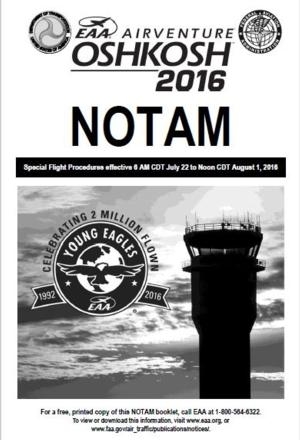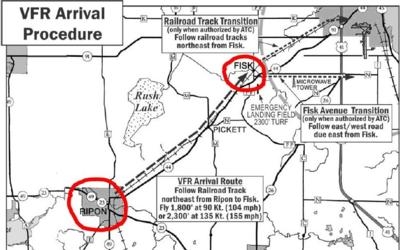Practicing Your Pilot Skills Prior To Arrival Relieves The Tension, Adds To The Fun, And Increases Safety
This is the third of a 6-part series by Earl Downs that we hope will help pilots who have never flown into EAA AirVenture Oshkosh and landed at Wittman Regional Airport. The remaining parts of our “how to” series will be published every Friday over the next 3 weeks.

For a recreational flyer, flying into Wittman Regional Airport during EAA AirVenture is part of the adventure. You’ll probably hear some wild stories about the arrival and departure procedures, but if you are prepared it’s a lot of fun. This time we’re going to talk about sharpening your pilot skills for the Fisk VFR arrival to Oshkosh.
The Safety Speech
The practice maneuvers I’ll be discussing are normal and safe, but don’t practice any flight maneuver you are not comfortable with without the help of an experienced safety pilot or flight instructor. Consider using a safety pilot or “airworthy” passenger for traffic watch and for taking notes.
The NOTAM instructs you on several things to do before arriving at the town of Ripon which begins the Fisk arrival procedure. Between Ripon and Fisk aircraft are asked to fly at a constant speed of 90 knots at an altitude of 1800 feet, or 125 knots, at an altitude of 2300 feet. These altitudes place you about 1,000 and 1,500 feet above the ground respectively.
The issue is, have you recently practiced holding altitude at specific speed? For our discussion, we’ll just pick the 90 knot speed. The procedures described for 90 knots also apply to the 125 knot speed. Of course, there will be some aircraft that cannot make it to 90 knots, so the NOTAM just says to use the maximum cruise speed.
Maintaining a Specific Cruise Speed and Level Flight.
When asked to maintain a specific cruise speed while holding altitude, you are combining a specific power to achieve a specific speed and holding altitude with pitch control which establishes the appropriate angle of attack. It will make it a lot easier if you have a plan for how to do this as you arrive over Ripon and head for Fisk. The following maneuvering practice will help you prepare.
Practice Maneuver
- Find an appropriate practice area; preferably one where you can use roads or section lines for a ground reference. Pick a safe altitude for the practice; I recommended to be 1,500 feet or better above the ground.
- Establish a track along your ground reference line and start experimenting with pitch and power to find out what it takes to hold 90 knots indicated airspeed while holding altitude. Do not use GPS groundspeed.
- When you’re holding the speed and altitude, trim the elevator and take a look at what you’ve got.
- Make notes of the power setting that you’re using to achieve level flight at 90 knots. Whatever works in this practice maneuver is what you’ll use as your starting point at Oshkosh. Let’s call this configuration “AV90-cruise”
- Once you’ve trimmed out your aircraft, it will want to maintain this balance. If you reduce power without changing trim, the aircraft will pitch down and start descending to maintain the speed, and if you add power the aircraft will pitch up to maintain the speed and climb.
- Practice establishing this AV90-cruise from normal cruise flight, from a descent, and from a climb.
Holding Altitude
- While you’re holding the AV90-cruise determine the power settings needed to produce a gentle climb or descent of about 200 feet per minute while holding steady at 90 knots.
- Practice climbing and descending to simulate adjusting your altitude. This will give you an idea of what pitch and power to use if you need to make minor adjustments after establishing AV90-cruise. Note your power settings.
Even though this maneuvering is a careful combination of pitch and power, I think of it this way; once you’re in the AV90-cruise, consider altitude a function of pitch and speed a function of power. It’s sometimes easier to approach this sort of maneuvering as a step-1…step-2 process.

Maneuvering
Once you’re using AV90-cruise and tracking a line, make a few 90 degree practice turns while maintaining the AV90-cruise. In a medium bank you’ll probably have to add a slight bit of power to maintain the speed while holding altitude. You need to be ready for maneuvering if you have to break the pattern and reenter, or to enter a hold.
The Wing Rock
You’ll probably be asked to rock your wings for identification at Fisk, and you need to be able to do that while maintaining AV90-cruise. For the controllers to be sure that they’re looking at the correct plane, the wing rock should be about a 25 degrees bank. It simply has to be a roll one way, then the other, then back to wings level. Practice this while you’re practicing the AV90-cruise. Work on your coordination and expect to be adding a bit of power to maintain your speed while you’re rocking your wings.
Slow Flight
The NOTAM is very specific about not overtaking other aircraft and admonishes that S-turns are not to be used. If you decide to slow down for traffic spacing it should only be considered if you are within sight of Fisk, and even then this is not the time to do minimum slow-flight procedures.
I recommend using a minimum speed of no less than your best angle of climb speed (Vx) rounded up to an easy-to-read number. I’ll call this “AV-slow speed.” Remember, if you slow down too far away from Fisk you could be causing problems behind you.
Slow Flight Practice
- As with your practice for AV90-cruise, pick a safe altitude and follow a ground track while establishing the pitch, power and trim to hold your ‘AV-Slow’ speed. Record the power setting.
- Practice changing back and forth from AV90-cruise to AV-slow while holding altitude.
- Remember, it may be easier if you think of pitch for altitude control and throttle for speed control.
- If it becomes necessary to break out of the arrival and start over at Ripon, be sure to return to your AV90-cruise configuration.
The Bottom Line
Practice before you go, write down the procedures that you intend to use, and be prepared at any time to break out of the pattern and return to Ripon for a reentry. Set personal limits and adhere to them.
(Images from file)
 ANN's Daily Aero-Term (04.25.24): Airport Rotating Beacon
ANN's Daily Aero-Term (04.25.24): Airport Rotating Beacon ANN's Daily Aero-Linx (04.25.24)
ANN's Daily Aero-Linx (04.25.24) Klyde Morris (04.22.24)
Klyde Morris (04.22.24) Airborne 04.24.24: INTEGRAL E, Elixir USA, M700 RVSM
Airborne 04.24.24: INTEGRAL E, Elixir USA, M700 RVSM Airborne 04.22.24: Rotor X Worsens, Airport Fees 4 FNB?, USMC Drone Pilot
Airborne 04.22.24: Rotor X Worsens, Airport Fees 4 FNB?, USMC Drone Pilot




